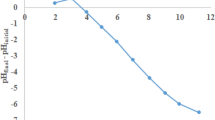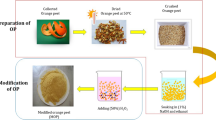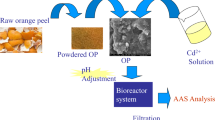Abstract
This study aims to explore the promising application of processed orange peel waste (POP) as a viable solution for effectively eliminating Mn(II) and Co(II) ions from water-based solutions. Co(II) ions were found to work best under the following conditions: 250 mg/L of starting concentration, 0.2 g of adsorbent dosage, 100 min of contact duration, and a solution pH of 6.05. Through meticulous experimentation, the optimal conditions for dealing with Mn(II) ions were identified, encompassing a starting concentration of 200 mg/L, 0.2 g as the adsorbent dose, 100 min of contact time, and maintaining a solution pH of 5.42. To delve deeper into surface characteristics of POP, the adsorption capabilities of Co(II) and Mn(II) ions were assessed at various temperatures (298 K, 308 K, and 318 K), revealing promising results: Co(II) displayed adsorption capacities of 21.432 mg/g, 23.364 mg/g, and 25.906 mg/g, while Mn(II) exhibited capacities of 20.366 mg/g, 22.123 mg/g, and 25.252 mg/g. Further analysis of the adsorption kinetics pointed to the pseudo-second-order model as the most accurate representation of the experimental data for both Co(II) and Mn(II) ions. Thermodynamic investigations have provided compelling evidence, affirming the endothermic and spontaneous essence of the adsorption process concerning these noble metal ions on POP. As a result, POP exhibited an exceptionally efficient and environmentally benevolent substitute material for the extraction of Co(II) and Mn(II) ions from aqueous media. Its innate ability to embrace these ions with efficacy highlights its intrinsic prowess in harmonizing with the environment, making it a true paragon of sustainable engineering. Its remarkable adsorption capacity, coupled with simple accessibility, cost-effectiveness, and its origin as an agricultural waste, positions it as a promising candidate for sustainable applications in water purification and environmental remediation.









Similar content being viewed by others
Data availability
The data that support the findings of this study are available from the corresponding author upon reasonable request.
References
Wei J, Zheng X, Liu J, Zhang G, Zhang Y, Wang C, Liu Y (2021) The levels, sources, and spatial distribution of heavy metals in soils from the drinking water sources of Beijing. China Sustainability 13(7):3719
Cui L, Wang X, Li J, Gao X, Zhang J, Liu Z (2021) Ecological and health risk assessments and water quality criteria of heavy metals in the Haihe River. Environ Pollut 290:117971
Canpolat M, Topal G (2023) Synthesis, characterization of cross-linked poly (ethylene glycol dimethacrylate-methyl methacrylate-N-(1-phenylethyl) acrylamide) copolymer and removal of copper (II), cobalt (II) ions from aqueous solutions via this copolymer. Environ Prog Sustain Energy 42:e14197
Zhang X, Yang Q (2018) Association between serum copper levels and lung cancer risk: a meta-analysis. J Int Med Res 46(12):4863–4873
Talan D, Huang Q (2022) A review study of rare earth, cobalt, lithium, and manganese in coal-based sources and process development for their recovery. Miner Eng 189:107897
Lemos VA, Junior IVS, Santos LB, Barreto JA, Ferreira SLC (2020) A new simple and fast method for determination of cobalt in vitamin B12 and water samples using dispersive liquid-liquid microextraction and digital image analysis. Water Air Soil Pollut 231:1–8
Altunkaynak Y, Canpolat M (2022) Ham Portakal Kabuğu ile Sulu Çözeltilerden Mangan (II) İyonlarının Uzaklaştırılması: Denge. Kinetik ve Termodinamik Çalışmalar AKU-FEMÜBİD 22(1):45–56
Garcia MD, Hur M, Chen JJ, Bhatti MT (2020) Cobalt toxic optic neuropathy and retinopathy: case report and review of the literature. Am J Ophthalmol Case Rep 17:100606
Mehrifar Y, Bahrami M, Sidabadi E, Pirami H (2020) The effects of occupational exposure to manganese fume on neurobehavioral and neurocognitive functions: an analytical cross-sectional study among welders. EXCLI J 19:372
Shehzad K, Xie C, He J, Cai X, Xu W, Liu J (2018) Facile synthesis of novel calcined magnetic orange peel composites for efficient removal of arsenite through simultaneous oxidation and adsorption. J Colloid Interface Sci 511:155–164
Kostić MM, Radović MD, Mitrović JZ, Bojić DV, Milenković DD, Bojić AL (2013) Application of new biosorbent based on chemicaly modified Lagenaria vulgaris shell for the removal of copper (II) from aqueous solutions: effects of operational parameters. Hemijska industrija 67(4):559–567
Onursal N, Altunkaynak Y, Baran A, Dal MC (2023) Adsorption of nickel (II) ions from aqueous solutions using Malatya clay: equilibrium, kinetic, and thermodynamic studies. Environ Prog Sustain Energy 42:e14150
Ahmad A, Mohd-Setapar SH, Chuong CS, Khatoon A, Wani WA, Kumar R, Rafatullah M (2015) Recent advances in new generation dye removal technologies: novel search for approaches to reprocess wastewater. RSC Adv 5(39):30801–30818
Ho S (2022) Low-cost adsorbents for the removal of phenol/phenolics, pesticides, and dyes from wastewater systems: a review. Water. 14(20):3203
Ninčević Grassino A, Djaković S, Bosiljkov T, Halambek J, Zorić Z, Dragović-Uzelac V et al (2020) Valorisation of tomato peel waste as a sustainable source for pectin, polyphenols and fatty acids recovery using sequential extraction. Waste and Biomass Valorization 11:4593–4611
Oluremi OIA, Ojighen VO, Ejembi EH (2006) The nutritive potentials of sweet orange (Citrus sinensis) rind in broiler production. Int J Poult Sci 5(7):613–617
Afolabi FO, Musonge P, Bakare BF (2022) Adsorption of copper and lead ions in a binary system onto orange peels: optimization, equilibrium, and kinetic study. Sustainability. 14(17):10860
Celus M, Kyomugasho C, Van Loey AM, Grauwet T, Hendrickx ME (2018) Influence of pectin structural properties on interactions with divalent cations and its associated functionalities. Comprehensive Reviews in Food Science and Food Safety 17(6):1576–1594
Yu H, Wang J, Yu JX, Wang Y, Chi RA (2020) Effects of surface modification on heavy metal adsorption performance and stability of peanut shell and its extracts of cellulose, lignin, and hemicellulose. Environ Sci Pollut Res 27:26502–26510
Feng NC, Guo XY (2012) Characterization of adsorptive capacity and mechanisms on adsorption of copper, lead and zinc by modified orange peel. Trans Nonferrous Met Soc Chin 22(5):1224–1231
Savastru E, Bulgariu D, Zamfir CI, Bulgariu L (2022) Application of Saccharomyces cerevisiae in the biosorption of Co (II), Zn (II) and Cu (II) ions from aqueous media. Water 14(6):976
Hosny NM, Rady S, Dossoki FIE (2022) Adsorption of methylene blue onto synthesized Co3O4, NiO, CuO and ZnO nanoparticles. J Iran Chem Soc 19:1877–1887
Loya-González D, Loredo-Cancino M, Soto-Regalado E, Rivas-García P, de Jesús Cerino-Córdova F, García-Reyes RB et al (2019) Optimal activated carbon production from corn pericarp: a life cycle assessment approach. J Clean Prod 219:316–325
Valerio-Cárdenas C, Martínez-Herrera J, Velázquez-Vargas DL, De la Cruz-Burelo P (2021) Determination of the point of zero charge of pineapple (Ananas comosus L.) peel and its application as copper adsorbent. AGROProductividad 14(11):53–59
Vidovix TB, Quesada HB, Bergamasco R, Vieira MF, Vieira AMS (2022) Adsorption of Safranin-O dye by copper oxide nanoparticles synthesized from Punica granatum leaf extract. Environ Technol 43(20):3047–3063
Bhattacharyya KG, Gupta SS (2011) Removal of Cu (II) by natural and acid-activated clays: an insight of adsorption isotherm, kinetic and thermodynamics. Desalination 272(1-3):66–75
Zhang Y, Xu S, Zhou H, Qi H, Wang H (2021) Adsorption of organic pollutants and heavy metal by Co-doped core-shell MoO2/Mo2C adsorbent. J Solid State Chem 293:121801
Oh WD, Lee MGH, Udayanga WC, Veksha A, Bao Y, Giannis A et al (2019) Insights into the single and binary adsorption of copper (II) and nickel (II) on hexagonal boron nitride: performance and mechanistic studies. J Environ Chem Eng 7(1):102872
Rahdar A, Rahdar S, Ahmadi S, Fu J (2019) Adsorption of ciprofloxacin from aqueous environment by using synthesized nanoceria. Ecol Chem Eng S 26(2):299–311
Medhi H, Chowdhury PR, Baruah PD, Bhattacharyya KG (2020) Kinetics of aqueous Cu (II) biosorption onto Thevetia peruviana leaf powder. ACS omega 5(23):13489–13502
Kostić MM, Hurt AP, Milenković DD, Velinov ND, Petrović MM, Bojić DV et al (2019) Effects of ultrasound on removal of ranitidine hydrochloride from water by activated carbon based on Lagenaria siceraria. Environ Eng Sci 36(2):237–248
Ashouri V, Adib K, Nasrabadi MR (2021) A new strategy for the adsorption and removal of fenitrothion from real samples by active-extruded MOF (AE-MOF UiO-66) as an adsorbent. New J Chem 45(11):5029–5039
Singh J, Basu S, Bhunia H (2019) CO2 capture by modified porous carbon adsorbents: effect of various activating agents. J Taiwan Inst Chem Eng 102:438–447
Demirbaş E (2003) Adsorption of cobalt (II) ions from aqueous solution onto activated carbon prepared from hazelnut shells. Adsorpt Sci Technol 21(10):951–963
Caramalău C, Bulgariu L, Macoveanu M (2009) Cobalt (II) removal from aqueous solutions by adsorption on modified peat moss. Chem Bull “POLITEHNICA” Univ (Timisoara) 54(68):13–17
Canpolat M (2023) Removing Co (II) and Mn (II) ions effectively from aqueous solutions by means of chemically non-processed Mardin stone waste: equivalent, kinetic, and thermodynamic investigations. Environ Prog Sustain Energy 42(3):e14042
Ahmadpour A, Tahmasbi M, Bastami TR, Besharati JA (2009) Rapid removal of cobalt ion from aqueous solutions by almond green hull. J Hazard Mater 166(2-3):925–930
Pu S, Hou Y, Yan C, Ma H, Huang H, Shi Q et al (2018) In situ coprecipitation formed highly water-dispersible magnetic chitosan nanopowder for removal of heavy metals and its adsorption mechanism. ACS Sustain Chem Eng 6(12):16754–16765
Foroutan R, Peighambardoust SJ, Ahmadi A, Akbari A, Farjadfard S, Ramavandi B (2021) Adsorption mercury, cobalt, and nickel with a reclaimable and magnetic composite of hydroxyapatite/Fe3O4/polydopamine. J Environ Chem Eng 9(4):105709
Ates A (2014) Role of modification of natural zeolite in removal of manganese from aqueous solutions. Powder Technol 264:86–95
Taffarel SR, Rubio J (2009) On the removal of Mn2+ ions by adsorption onto natural and activated Chilean zeolites. Miner Eng 22 (4):336–343
Kebabi B, Terchi S, Bougherara H, Reinert L, Duclaux L (2017) Removal of manganese (II) by edge site adsorption on raw and milled vermiculites. Appl Clay Sci 139:92–98
Kara I, Tunc D, Sayin F, Akar ST (2018) Study on the performance of metakaolin based geopolymer for Mn (II) and Co (II) removal. Appl Clay Sci 161:184–193
Li Y, Huang H, Xu Z, Ma H, Guo Y (2020) Mechanism study on manganese (II) removal from acid mine wastewater using red mud and its application to a lab-scale column. J Clean Prod 253:119955
Tulashie SK, Kotoka F (2022) Kinetics and thermodynamic studies on Moringa oleifera oil extraction for biodiesel production via transesterification. Biofuels. 13(3):341–349
Altunkaynak Y (2023) Using chemically unprocessed orange peel to effectively remove Hg (II) ions from aqueous solutions: equivalent, thermodynamic, and kinetic investigations. Sakarya University Journal of Science 27(1):189–203
Kostić M, Đorđević M, Mitrović J, Velinov N, Bojić D, Antonijević M, Bojić A (2017) Removal of cationic pollutants from water by xanthated corn cob: optimization, kinetics, thermodynamics, and prediction of purification process. Environ Sci Pollut Res 24:17790–17804
Altunkaynak Y, Canpolat M (2022) Sulu Çözeltilerden Nikel (II) İyonlarının Uzaklaştırılmasında Portakal Kabuğu Atığının Kullanılması: Denge. Kinetik Ve Termodinamik Çalışmalar JARNAS 8(2):322–339
Canpolat M, Altunkaynak Y, Yavuz Ö (2022) Bakır (II) İyonlarının Sulu Çözeltilerden Atık Portakal Kabuğu İle Uzaklaştırılması: Denge. Kinetik Ve Termodinamik Çalışmalar AKU-FEMÜBİD 22(3):498–507
Altunkaynak Y, Canpolat M, Aslan M (2023) Adsorption of lead (II) ions on kaolinite from aqueous solutions: isothermal, kinetic, and thermodynamic studies. Ionics 29:4311–4323
Acknowledgements
The Batman University and Dicle University Science and Technology Application and Research Center (DUPTAM) are sincerely acknowledged by the authors for their assistance.
Author information
Authors and Affiliations
Contributions
M. C., conceptualization, methodology, software, investigation, writing original draft. Y. A., validation, data curation, writing—original draft—review and editing, supervision. The final manuscript was reviewed and approved by all writers.
Corresponding author
Ethics declarations
Ethical approval
This work was carried out by obeying research and ethics rules.
Conflict of interest
The author declare no competing interests.
Additional information
Publisher’s Note
Springer Nature remains neutral with regard to jurisdictional claims in published maps and institutional affiliations.
Rights and permissions
Springer Nature or its licensor (e.g. a society or other partner) holds exclusive rights to this article under a publishing agreement with the author(s) or other rightsholder(s); author self-archiving of the accepted manuscript version of this article is solely governed by the terms of such publishing agreement and applicable law.
About this article
Cite this article
Canpolat, M., Altunkaynak, Y. Use of low-cost processed orange peel for effective removal of cobalt (II) and manganese (II) from aqueous solutions. Ionics 30, 591–605 (2024). https://doi.org/10.1007/s11581-023-05291-6
Received:
Revised:
Accepted:
Published:
Issue Date:
DOI: https://doi.org/10.1007/s11581-023-05291-6




